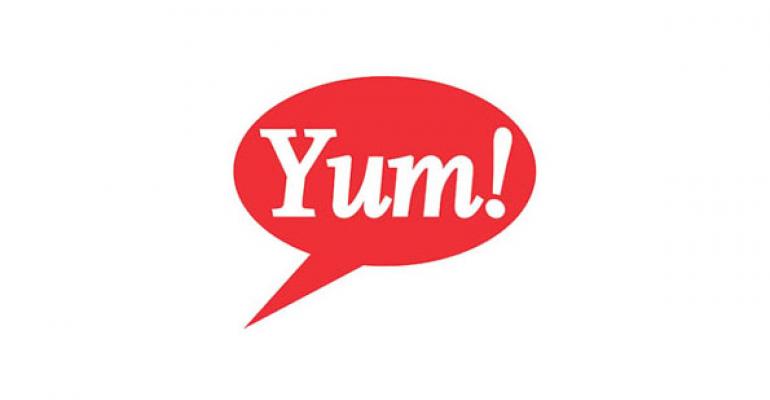Yum! Brands Inc. updated its annual guidance Friday to disclose that same-store sales within its powerhouse China division would fall 4 percent for the fourth quarter, which led the company’s stock to fall as much as 10 percent during trading.
The Louisville, Ky.-based operator or franchisor of KFC, Pizza Hut and Taco Bell stated in a release that same-store sales in China would turn negative in the fourth quarter, compared with a 21-percent increase in the fourth quarter of 2011. Previously, Yum had guided investors to expect same-store sales in China to be flat or up in the low single digits in the fourth quarter.
Fourth-quarter comparable sales are expected to rise 4 percent at its Yum! Restaurants International, or YRI, division and 3 percent in the United States.
On news of slowing sales in China, Yum’s fastest-growing and most profitable division for several years, the company’s share price fell as much as 10 percent to $66.98 per share Friday afternoon during trading. The stock closed Friday at $67.08, down 9.9 percent from the previous day. Yum’s stock closed Thursday at $74.47, after hitting a 52-week high of $74.75.
RELATED
• Analyst bullish on Yum growth after Asia visit
• Yum franchisee gives advice on restaurant financing
• More restaurant industry finance news
Yum Brands chief executive officer David Novak said full-year 2012 same-store sales in China are expected to increase 6 percent. He also foreshadowed a strong 2013.
“Next year will be another strong year for our China division,” he said, “given this year’s record development of at least 800 new units and significant innovation in the pipeline, underpinned by world-class operations. We are extremely confident Yum China remains the best growth story in the restaurant industry.”
In addition to the 800-plus locations to be opened in China this year — which beats the guidance of at least 750 openings the company projected after reporting third-quarter earnings — Yum also expects to have opened at least 950 restaurants in its International division and 100 locations in India, which became a separate operating division this past year.
Yum also reaffirmed its guidance of at least 13-percent growth in fiscal 2012 earnings per share, up from $2.74 per share earned in fiscal 2011. The company projected earnings per share growth of at least 10 percent for 2013.
Several securities analysts covering Yum speculated that investors may turn cool toward the company if the division that generates more than 40 percent of its operating profit experiences a prolonged slump.
In a research note, Andy Barish of Jefferies & Co. wrote that some subtle changes in Yum’s long-term business model in China raises questions about the company’s ability to continue its torrid pace of earnings growth. He noted that Yum management indicated China’s growth would be driven more by new-unit expansion than by same-store sales increases.
“What could be concerning is that 2013 guidance calls for 700 new units in China, down from 800 in 2012,” he wrote. “New city centers are still emerging, but at a slower pace, and we wonder if management is tempering its development plans to adapt to this change.”
Bryan Elliott of Raymond James & Associates also called Yum’s earnings projections for next year into question after the “very surprising negative sales warning for China.” He wrote in a research note that Yum’s fourth-quarter expectations for China imply a decrease in traffic of about 9 percent, as the 4-percent decline in same-store sales is projected during a quarter in which Yum China’s menu prices were running 5 percent higher than a year earlier.
“We believe the somewhat shocking deterioration in China traffic trends creates significant visibility issues for earnings per share over the next few quarters at least,” Elliott wrote. “While management did reiterate fiscal-2012 earnings per share guidance of $3.24, the lack of sales visibility in China clearly creates some risk to the company’s initial 2013 [earnings per share] growth guidance of at least 10 percent.”
Sara Senatore of Bernstein Research, however, wrote that Yum’s expected sales and traffic declines in China are driven by caution among Chinese consumers stemming from November’s change in Communist Party leadership. Those consumers likely will become more willing to spend at restaurants once post-transition certainty returns, she noted.
Over the long term, she added, Yum should successfully expand into underpenetrated markets in China’s interior cities and replicate the first-mover advantages it realized years ago as it developed KFC and Pizza Hut in China’s huge coastal cities.
“While Yum appears to have taken a slightly more conservative view on China for its longer-term [same-store sales] guidance, with unit growth driving more of the top-line growth,” Senatore wrote, “we would expect comps to reaccelerate as comparisons ease and confidence returns.”
Yum operates or franchises more than 38,000 restaurants in more than 120 countries.
Contact Mark Brandau at [email protected].
Follow him on Twitter: @Mark_from_NRN





